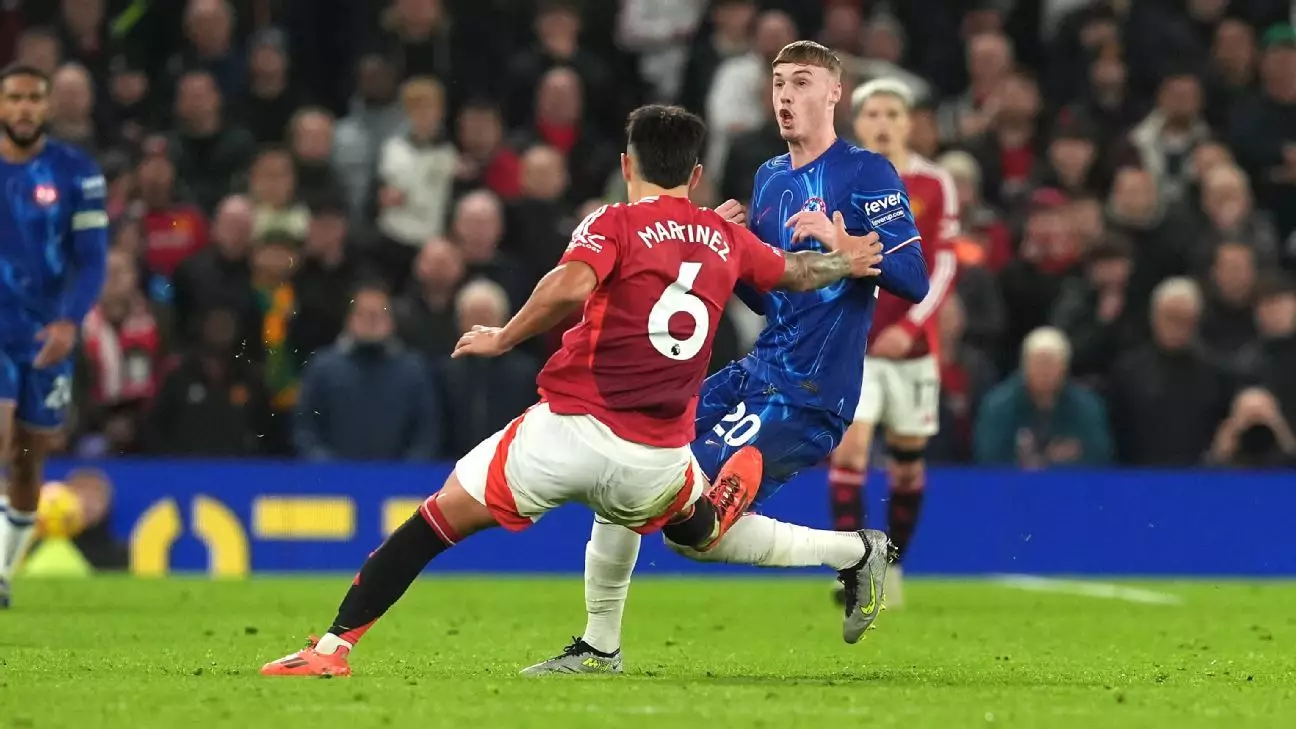The Video Assistant Referee (VAR) system continues to ignite passionate debates among fans, players, and pundits across the Premier League. Each week, crucial decisions made under this technology stir controversy, raising questions not just about the calls themselves, but about the criteria and context that guide these decisions. Analyzing specific incidents from recent matches reveals not only the contentious nature of VAR but also the different interpretations that can arise based on established protocols and laws governing the game.
Lisandro Martinez’s Challenge: A Case Study in Subjectivity
One such incident came during a match featuring Manchester United’s Lisandro Martinez and Chelsea’s Cole Palmer. As the game approached its climax, Martinez’s attempt to thwart Palmer’s advance led to a significant yellow card issued by referee Rob Jones. However, the intervention by VAR official Michael Salisbury sparked disbelief when no red card was deemed necessary. This decision encapsulates the ongoing struggles with determining what constitutes a serious foul.
While many fans argued that Martinez’s high challenge, which caught Palmer’s knee with visible force, warranted a harsher punishment, the VAR’s judgment hinged on the perceived intent and severity of the foul. Last season, similar situations resulted in a mixed bag of outcomes where inconsistencies in officiating attitudes were glaring. Martinez appeared fortunate to escape harsher scrutiny, demonstrating how VAR often balances on a precarious tightrope, with referees appearing reluctant to overrule their on-field judgments.
Understanding Penalty Decisions: A Fine Line
In another notable episode, Manchester United was awarded a penalty after Robert Sánchez collided with Rasmus Højlund. This decision, confirmed by VAR, underscored the system’s function when it comes to evaluating contact within the penalty area. VAR stripped the match of subjectivity in this scenario, as definitive contact was established through footage. Unlike the earlier instance with Martinez, where subjective interpretation dominated, in this case, precise evidence substantiated the referee’s call.
Nevertheless, concerns regarding the consistency of officiating decisions still linger. The parameters surrounding when VAR should intervene remain a point of contention, especially when juxtaposed against erratic implementations of the same laws in various situations. Fans across the league continue to call for clearer guidelines that can prevent the discrepancies seen in earlier seasons.
The plight of Ipswich Town, having had no penalties awarded in their favor but several controversial calls against them, poses an analysis of how VAR influences lower-tier teams within the competitive fabric of the Premier League. Chairman Mark Ashton palpably expressed his frustration as he scrutinized the gap between expectation and reality in VAR adjudications. Ipswich’s situation illustrates that while the subjective nature of refereeing persists, some clubs face a higher frequency of unfavorable assessments.
Despite Ipswich’s grievances, scrutiny from the Key Match Incidents (KMI) Panel revealed that decisions regarding penalties and fouls consistently aligned with the narrative that VAR did not err. This showcases the high standards expected for VAR interventions in the league, emphasizing the need for patience from clubs adjusting to a fundamentally new method of officiating.
The recent disallowance of a stoppage-time winner by Crystal Palace encapsulated one of VAR’s significant challenges: reviewing goals involving goalkeeper control. Referee Anthony Taylor ruled out the goal due to perceived goalkeeper interference, which was upheld upon review. The crux of the debate revolves around how the laws define control when a goalkeeper is in possession. Fans and managers alike are often left puzzled by the margins that separate legality and infringement in such critical moments.
This scenario echoes previous decisions made in the league, illustrating that consistency regarding goalkeepers’ rights and players’ actions taken may vary drastically from game to game. The ongoing confusion propels calls for clearer interpretation of these moments.
Multiple incidents across games, such as James Tarkowski’s challenge on Cameron Archer, spotlight the dividing line between expected yellow cards and those that might warrant a red. VAR’s repetitive indecision highlights further the need for more definitive standards concerning potentially dangerous tackles. The argument lies in whether these fouls truly meet the threshold for a significant foul in the eyes of official channels or fall into subjective interpretations subject to inconsistency.
Each decision, or lack thereof, serves as a reminder that while VAR promises clarity, the human element of judgment still permeates each match situation. Discrepancies, such as Jan Bednarek’s yellow card for bringing down an opponent, repeatedly evoke discussions around the appropriate penalties for varying degrees of fouls.
The intricacies of VAR in the Premier League transcend beneath the surface of every controversial decision. As clubs, players, and fans navigate this evolving adjudication process, the narrative remains that consistency is key. In an ever-evolving game, the balance between technology and human judgment inevitably leads to diverse opinions and intense debates. Moving forward, FIFA and the Premier League must examine these discrepancies to promote a more unified approach to officiating decisions, ensuring fairness and clarity in the beautiful game.
